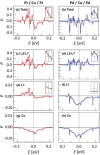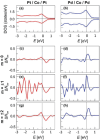Sign Reversal of Spin-Transfer Torques
- PMID: 38626368
- PMCID: PMC11304287
- DOI: 10.1002/advs.202309467
Sign Reversal of Spin-Transfer Torques
Abstract
Spin-transfer torque (STT) and spin-orbit torque (SOT) form the core of spintronics, allowing for the control of magnetization through electric currents. While the sign of SOT can be manipulated through material and structural engineering, it is conventionally understood that STT lacks a degree of freedom in its sign. However, this study presents the first demonstration of manipulating the STT sign by engineering heavy metals adjacent to magnetic materials in magnetic heterostructures. Spin torques are quantified through magnetic domain-wall speed measurements, and subsequently, both STT and SOT are systematically extracted from these measurements. The results unequivocally show that the sign of STT can be either positive or negative, depending on the materials adjacent to the magnetic layers. Specifically, Pd/Co/Pd films exhibit positive STT, while Pt/Co/Pt films manifest negative STT. First-principle calculations further confirm that the sign reversal of STT originates from the sign reversal of spin polarization of conduction electrons.
Keywords: magnetic domain‐walls; spin polarization; spintronics; spin‐transfer torques.
© 2024 The Author(s). Advanced Science published by Wiley‐VCH GmbH.
Conflict of interest statement
The authors declare no conflict of interest.
Figures





References
-
- Berger L., Phys. Rev. B 1996, 54, 9353. - PubMed
-
- Slonczewski J. C., J. Mag. Mag. Mater. 1996, 159, L1.
-
- Bertram H. N., Zhu J.‐G., Solid State Phys. 1992, 46, 271.
-
- Chappert C., Fert A., Van Dau F. N., Nat. Mater. 2007, 6, 813. - PubMed
-
- Brataas A., Kemt A. D., Ohno H., Nat. Mater. 2012, 11, 372. - PubMed
Grants and funding
- SSTF-BA1802-07/Samsung Science and Technology Foundation
- 2015R1A2A1A05001698/Ministry of Science and ICT, South Korea
- 2015M3D1A1070465/Ministry of Science and ICT, South Korea
- 2017R1A2B300262/Ministry of Science and ICT, South Korea
- 2020R1C1C1006194/Ministry of Science and ICT, South Korea
- 2020R1A5A1016518/Ministry of Science and ICT, South Korea
- 2019R1I1A3A01059880/Ministry of Science and ICT, South Korea
- NRF-2022M3I7A2079267/National Research Foundation of Korea (NRF)
- NRF-2022R1A2C2004493/National Research Foundation of Korea (NRF)
- 2E32251/KIST Institutional Program
- 2E32951/KIST Institutional Program
- 2022M3H4A1A04096339/Ministry of Science and ICT, South Korea
LinkOut - more resources
Full Text Sources
